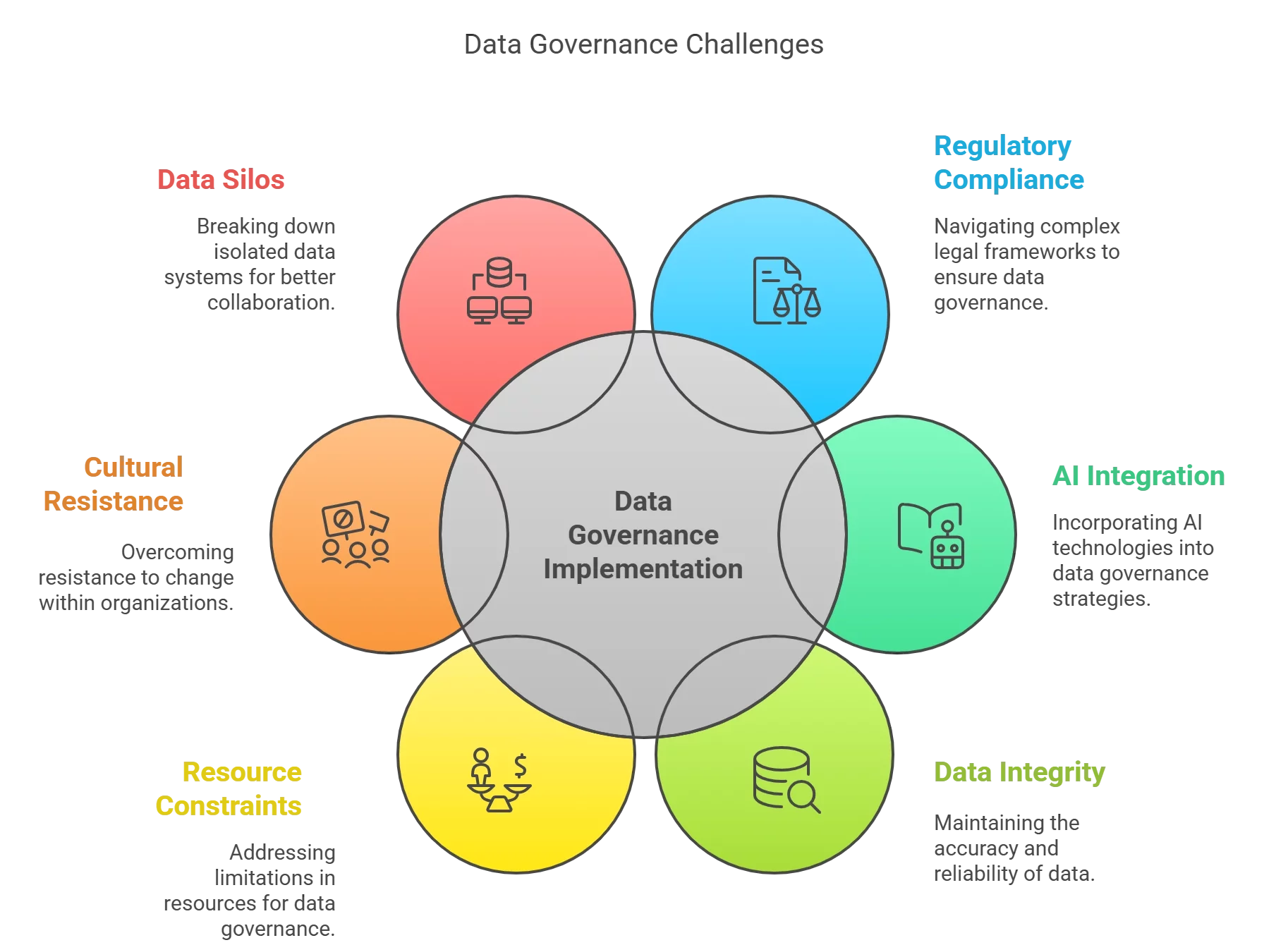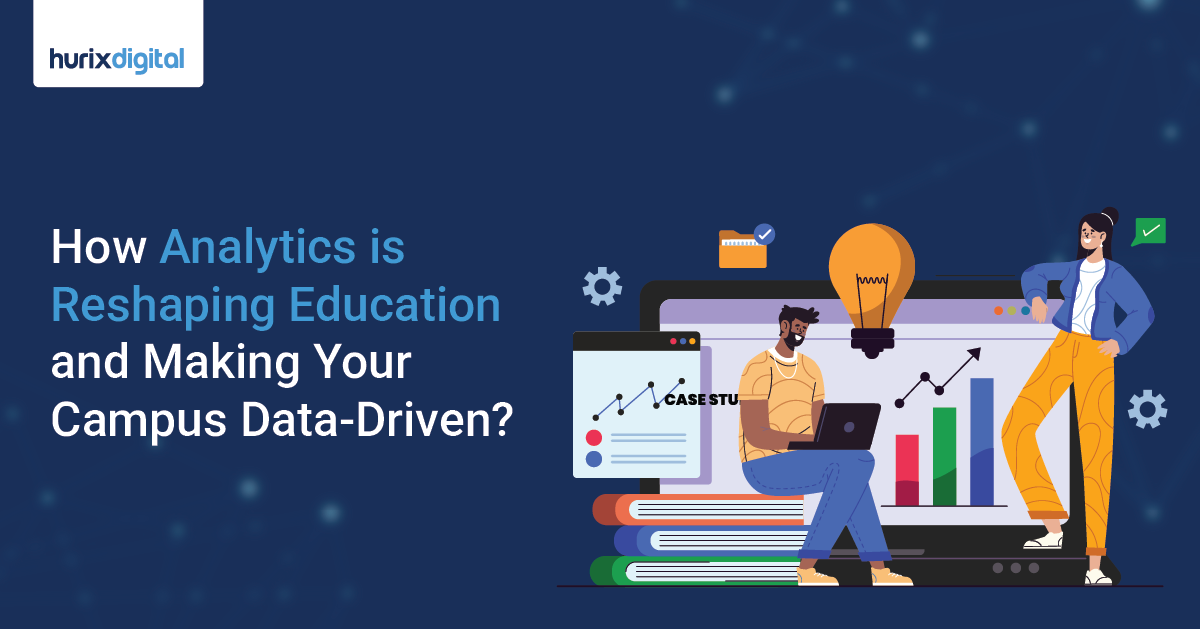
Making Student Data Management Simple and Secure with Smart Solutions
Summarize with:
Integration as a Service (IaaS) offers a cloud-based solution to streamline campus data integration, automate administrative tasks, and improve data accuracy. As institutions shift toward data-driven decision-making, IaaS enhances efficiency, supports digital transformation, and ensures compliance.
Managing student records in higher education is increasingly getting complex due to challenges like data silos, manual processes, and outdated legacy systems. Digital transformation is a growing challenge in higher education, with 69% of leaders now citing it as a major issue.
Integration as a Service (IaaS) offers a transformative solution by streamlining campus data integration and automating department processes. This approach enhances data accuracy and reduces administrative burdens. It supports advancements in cloud-based solutions and digital transformation in higher education.
As institutions embrace data-driven decision-making, IaaS becomes pivotal. It optimizes the education process automation, enabling seamless data integration for the future of digital transformation.
Table of Contents:
- Understanding Integration as a Service in Higher Education
- Why is Integration Essential?
- Three Key Benefits of Data Integration in Education
- Cloud-Based Integration Solutions: The Backbone of Campus Data Integration
- Streamlining Student Records with Education Process Automation
- Understanding Data Governance in Education
- Six Key Challenges in Implementing Data Governance
- AI-Driven Data Security: Protecting Sensitive Information
- 8 Best Practices for Data Governance
- Frameworks for AI and Data Governance
- Leveraging AI for Enhanced Data Analytics
- The Future of Campus Data Integration
- Conclusion
Understanding Integration as a Service in Higher Education
IaaS is a cloud-based method that links different school data systems, facilitating smooth data integration among various departments. The main elements of IaaS comprise cloud-connected integration solutions, live data synchronization, and API handling.
All of these aid in consolidating data from student records, finance, human resources, and other vital sectors. Through the centralization of student data management, IaaS enables organizations to simplify operations, increase data precision, and enhance overall decision-making processes.
IaaS is crucial in higher education for overcoming legacy system limitations like data silos and manual processes. It streamlines the automation of education processes and facilitates digital transformation with a scalable, secure, and cost-efficient solution.
According to McKinsey, universities that have implemented centralized data integration have experienced enhancements in student retention and operational efficiency. Some schools have even reported a 5% rise in enrollment within 16 months of adopting this approach.
Why is Integration Essential?
Due to digital transformation, educational institutions are changing their operations, moving towards interactive and technology-based learning environments. The emergence of COVID-19 accelerated this change, prompting universities to embrace online and hybrid formats. This shift increased the importance of technology in day-to-day education.
A survey found that 67% of educational institutions noted a rise in utilizing digital resources like AI-powered learning platforms and cloud-based systems. This shows a stronger dependence on technology to improve learning results and operational effectiveness.
Here are the necessities of data integration in digital transformation:
- Enhanced Learning and Operations: Smooth data integration drives overall digital transformation. It facilitates instant data retrieval, customized learning experiences, and streamlined administrative tasks.
- Drawbacks of Lack of Integration: Organizations without integrated systems experience disconnected information, inefficiencies in operations, and restricted decision-making capacities. This prevents them from fully utilizing the advantages of digital transformation.
According to McKinsey’s study on the effects of disconnected technologies in education, inaccurate data can result in poorly informed tactics and less-than-ideal student achievements.
As educational institutions evolve digitally, data integration is not just a technical upgrade but a critical component for ensuring cohesive, effective, and scalable digital education strategies.

Three Key Benefits of Data Integration in Education
Data integration is critical in modernizing higher education institutions by enhancing operational efficiency and student data management. Here’s how integrated data systems improve accuracy, support strategic decision-making, and simplify administrative tasks:
1. Improved Data Accuracy and Accessibility
Data integration in education significantly enhances data accuracy by reducing manual data entry errors and eliminating redundant data systems. Centralized platforms allow seamless data integration across departments, providing real-time access to accurate information for students, staff, and administrators.
According to McKinsey, institutions implementing integrated data systems see improved data hygiene, which makes accessing consistent and reliable data across the campus easier.
2. Enhanced Decision-Making for University Registrars
Integrated data enables university registrars to make strategic decisions by generating comprehensive insights from all the sources from which the data is drawn. Such integrated data helps manage enrollment efficiently, better allot resources, and target interventions to change student outcomes.
For example, universities that use integrated analytics platforms have observed improved student enrollment and retention rates as they make better data-based decisions.
3. Simplification of Administrative Tasks
Integrating data systems to automate educational processes simplifies administrative tasks by streamlining repetitive activities like admissions, grading, and reporting. This decreases administrative staff work, allowing them to concentrate on activities that add more value.
Studies emphasize that higher education automation assists institutions in optimizing operations, resulting in increased productivity and decreased operational expenses.
Cloud-Based Integration Solutions: The Backbone of Campus Data Integration
Cloud-based integration solutions are changing the higher education environment by offering a smooth platform for integrating data among different campus systems. These solutions enable institutions to link various data sources, streamline processes, and improve decision-making abilities. Cloud services like Google Cloud and AWS are favored in higher education for their scalability, security, and student data management capabilities.
For instance, cloud-based AI-powered software usage has increased by 19% since the pandemic, helping institutions adapt course content and automate administrative tasks. This shift has improved operational efficiency and enabled more personalized student learning experiences. Furthermore, cloud integration reduces the operational burden of maintaining traditional hardware and software, making it a key driver of campus data integration.

Streamlining Student Records with Education Process Automation
The automation of the education process is changing how colleges and universities handle student records by automating tasks like admissions, grading, and attendance tracking. This automation improves data integration in education by ensuring student information remains consistent, accessible, and up-to-date on various platforms.
1. Automated Admissions
The admissions process is more efficient when information from application forms, transcripts, and test scores is incorporated. This decreases mistakes in manual data entry and accelerates decision-making. Organizations employing automated admissions processes have noted considerable time efficiency and increased precision in assessing applicants.
2. Grading and Assessment Automation
Automated grading tools streamline assessments, offering prompt and precise feedback to students while allowing instructors more time for individualized student interactions. These tools aid in upholding uniform grading criteria and lessen the administrative burden on faculty.
3. Attendance Tracking
Automated attendance systems monitor student involvement in real-time, whether in traditional classrooms or virtual settings. This information assists institutions in recognizing students who are at risk and require extra help, leading to higher retention rates.
Understanding Data Governance in Education
Data governance in education involves overseeing data availability, usability, integrity, and security in educational organizations. It encompasses the measures and systems utilized to responsibly manage educational data.
Data governance is crucial in this industry. It guarantees that schools adhere to legal requirements while maximizing data utilization to improve student results and operational effectiveness.
Integrating AI-powered data security into these governance frameworks enhances protection, safeguarding sensitive student data from new cyber threats. Additionally, abiding by Educational Data Compliance assists schools in navigating the intricate network of rules that oversee data privacy and usage.
Implementing robust AI and data governance frameworks results in a secure and accessible data environment. This enables organizations to use AI-powered data analytics to acquire information that guides strategic decisions and improves educational services.

Six Key Challenges in Implementing Data Governance
Implementing data governance in education presents unique challenges, particularly for CIOs and CTOs who are at the helm of technological advancements in educational institutions. Here are some common hurdles they face:
1. Complex Regulatory Environment
Navigating the laws and regulations related to educational data compliance can be daunting. Each regulation demands strict adherence, complicating student data management.
2. Integration of AI Technologies
Incorporating AI-driven data security and AI-powered data analytics requires advanced technical strategies. Ensuring these technologies align with existing systems adds complexity.
3. Ensuring Data Integrity
Maintaining the accuracy and consistency of educational data is critical for upholding data integrity in educational institutions.
4. Resource Constraints
Limited budget and manpower hinder the implementation of effective data governance frameworks and lead to prioritization dilemmas.
5. Cultural Resistance to Change
Instituting a culture that embraces data-driven decision-making and governance can meet resistance from staff accustomed to traditional methods.
6. Data Silos
Breaking down data silos to ensure seamless data flow across various departments remains a persistent challenge. Effective risk management and governance depend on such seamless data integration.
In 2023, 29% of K12 school attacks were due to vulnerability exploitation, while phishing campaigns accounted for 30%. This underscores the growing importance of using AI technology in data security to address escalating threats.
AI-Driven Data Security: Protecting Sensitive Information
In the field of data governance in education, ensuring AI-driven data security is crucial for protecting sensitive information. Below are the ways artificial intelligence enhances data security measures:
- Automated Threat Detection: Artificial intelligence algorithms are highly effective at recognizing possible security risks in live situations. Proactive strategies are essential for ensuring the security of student and staff data.
- Enhanced Encryption Methods: AI can create intricate encryption keys that are hard for hackers to decipher, thus improving encryption techniques. This ensures data protection while stored and during transfer.
- Behavioral Analytics: AI systems scrutinize user behavior to detect unusual activities that might indicate a security breach. Early detection of such anomalies is key to preventing data leaks and safeguarding sensitive information.
- Access Control Improvements: AI helps improve access control systems by adjusting to evolving risk situations. Using real-time evaluations guarantees that only approved individuals can access confidential data.
- Automation of compliance: AI tools streamline compliance procedures, ensuring consistent conformity with educational data compliance standards without manual supervision.
According to IBM’s report, organizations that extensively use security AI and automation for prevention report average cost savings of $2.22 million compared to those that do not. AI-enhanced security measures can reduce these risks by proactively identifying vulnerabilities and automating compliance checks.

8 Best Practices for Data Governance
Effective data governance in education requires strategic planning and robust implementation. Here are actionable best practices tailored for educational institutions to enhance their governance frameworks:
1. Establish Clear Data Governance Policies
Define roles and responsibilities for student data management within educational institutions. These policies must be comprehensive and communicated across all levels of the organization, ensuring consistent implementation.
2. Implement Data Quality Standards
High criteria for data accuracy and completeness are essential for successful data governance. Educational institutions need to routinely carry out audits to ensure that these standards are upheld and that the data remains beneficial for informed decision-making.
3. Develop a Data Governance Framework
A robust data governance framework is essential. Such a framework should incorporate AI that leverages advanced tools and procedures for data security, quality control, and regulatory compliance, catering specifically to the unique needs of educational environments.
4. Regular Training and Awareness
Continuous education and training are crucial to make sure all employees know the data governance policies and grasp the importance of data security. These meetings assist in creating an informed team that can recognize and address possible data problems before they become more serious.
5. Leverage AI for Data Security
Utilizing AI-powered data security can improve a company’s capacity to identify and address potential risks. AI technologies facilitate the proactive monitoring and analysis of data usage patterns, helping to prevent unauthorized access and potential breaches.
6. Data Compliance Monitoring
Continuous monitoring of data processes is crucial for adhering to regulations in the education sector. AI tools automate these checks and simplify the reporting process, ensuring institutions meet regulatory standards with reduced manual intervention.
7. Integrate Data Risk Management Practices
Recognizing possible dangers and weaknesses is a proactive method for managing data. Institutions need to create thorough plans to reduce these risks, consistently reassessing and adapting necessary steps to combat new and changing dangers.
8. Utilize AI-Powered Data Analytics
AI-driven data analytics enable educational institutions to more effectively interpret their data, aiding in strategic decision-making and policy development. This technology is valuable for identifying inefficiencies and enhancing governance practices.
Frameworks for AI and Data Governance
Effective AI and data governance frameworks are essential for integrating AI into data governance strategies within educational institutions. Here are vital frameworks that support this integration:
- Control Objectives for Information and Related Technologies (COBIT) ensures that IT goals are aligned with strategic institutional objectives and that AI technologies improve data governance and compliance.
- ISO/IEC 38500 offers guidance for governing bodies on incorporating it, including AI, into their organizations, with a focus on robust governance and data integrity within educational institutions.
- DAMA-DMBOK, which stands for Student Data Management Body of Knowledge, offers established guidelines for student data management that can be adapted to include AI-based technologies, enhancing security and decision-making abilities.
- Although the principles of the General Data Protection Regulation (GDPR) are exclusive to the EU, they have a broad impact worldwide. They stress the importance of safeguarding personal information by implementing responsible student data management techniques, which include ensuring AI compliance in education.
- NIST framework provides standards and guidelines for educational institutions to safeguard their information systems, which is essential for incorporating AI-driven data security measures.
Leveraging AI for Enhanced Data Analytics
Leveraging AI-powered data analytics can significantly transform data handling and decision-making processes. Here’s how AI facilitates these changes:
- Predictive Analytics: AI tools analyze historical data to forecast future trends. Such capabilities enable educational institutions to address potential challenges and adapt strategies for student success proactively.
- Personalized Learning Experiences: AI can analyze student data to personalize educational content based on individual learning styles and needs, improving engagement and results.
- Efficiency in Data Processing: AI speeds up the handling of extensive data sets, enabling instantaneous data analysis. This timely access to data-driven insights supports more informed and swift decision-making.
- Enhanced Data Security: By incorporating AI-driven data security measures, AI analytics tools can identify and mitigate potential threats in real-time, safeguarding sensitive educational data.
- Compliance Monitoring: AI assists in ensuring that data practices comply with educational data compliance standards by automating data audits and promptly reporting discrepancies.
The Future of Campus Data Integration
Here are a few important trends that are expected to influence the future of campus data integration:
- AI-Driven Integration: AI technology advancements will improve the integration and analysis of complex data, leading to personalized learning and more efficient campus operations.
- Increased Automation: Automation is expected to simplify further administrative duties, such as admissions and financial aid processing, decreasing manual mistakes and enhancing efficiency.
- Predictive Analytics: In predictive analytics, increasingly sophisticated predictive models will aid in forecasting student success, optimizing resource allocation, and addressing challenges like retention and enrollment management.
Reports show that advanced AI and machine learning models are currently being utilized to tackle intricate educational requirements. This shows a shift towards smarter and more interconnected data systems that enhance decision-making and student results.
Conclusion
Embracing integration solutions is crucial for higher education institutions aiming to streamline processes and improve student record management. Seamless data integration enhances data accuracy, facilitates education process automation, and enables real-time access to critical information, supporting efficient decision-making and boosting overall campus operations.
By adopting cloud-based integration solutions, universities can break down data silos, foster digital transformation, and create a more cohesive and responsive educational environment.
Investing in these advanced technologies optimizes administrative functions and enhances the overall student experience, driving success and innovation across the institution. To explore how your institution can benefit from advanced integration solutions, connect with Hurix Digital and transform your student data management practices today.
Connect with us to discuss how we can help streamline student records and processes.
Frequently Asked Questions (FAQs)
Q1: What defines a secure student data management system?
A1: It uses encryption, role‑based access, audit logs, and secure backups to protect sensitive student information.
Q2: How does automation improve student data workflows?
A2: It reduces errors, speeds up enrollment, grading, and reporting, and ensures data consistency.
Q3: What integrations are important for data platforms?
A3: SIS, LMS, BI tools, and parental communication systems should all connect seamlessly.
Q4: How can admins detect data anomalies?
A4: Smart alerts and automated reports flag missing, inconsistent, or outdated information in real time.
Q5: What compliance rules must be followed?
A5: GDPR, FERPA, COPPA, and local privacy laws apply to student data protection in education.
Summarize with:

Senior Vice President
A Business Development professional with >20 years of experience with strong capability to sell new solutions and develop new markets from scratch. New Market Entry Specialist with experience working in the largest emerging markets. Exceptional experience in conceptualizing, ideating and selling new learning technologies like VR AR, etc. across multiple industry verticals.
 Upcoming Masterclass | Build an Army of Brand Evangelists using Training & Development | November 20th, 8:30 AM PDT | 11:30 AM EDT | 10:00 PM IST
Upcoming Masterclass | Build an Army of Brand Evangelists using Training & Development | November 20th, 8:30 AM PDT | 11:30 AM EDT | 10:00 PM IST




